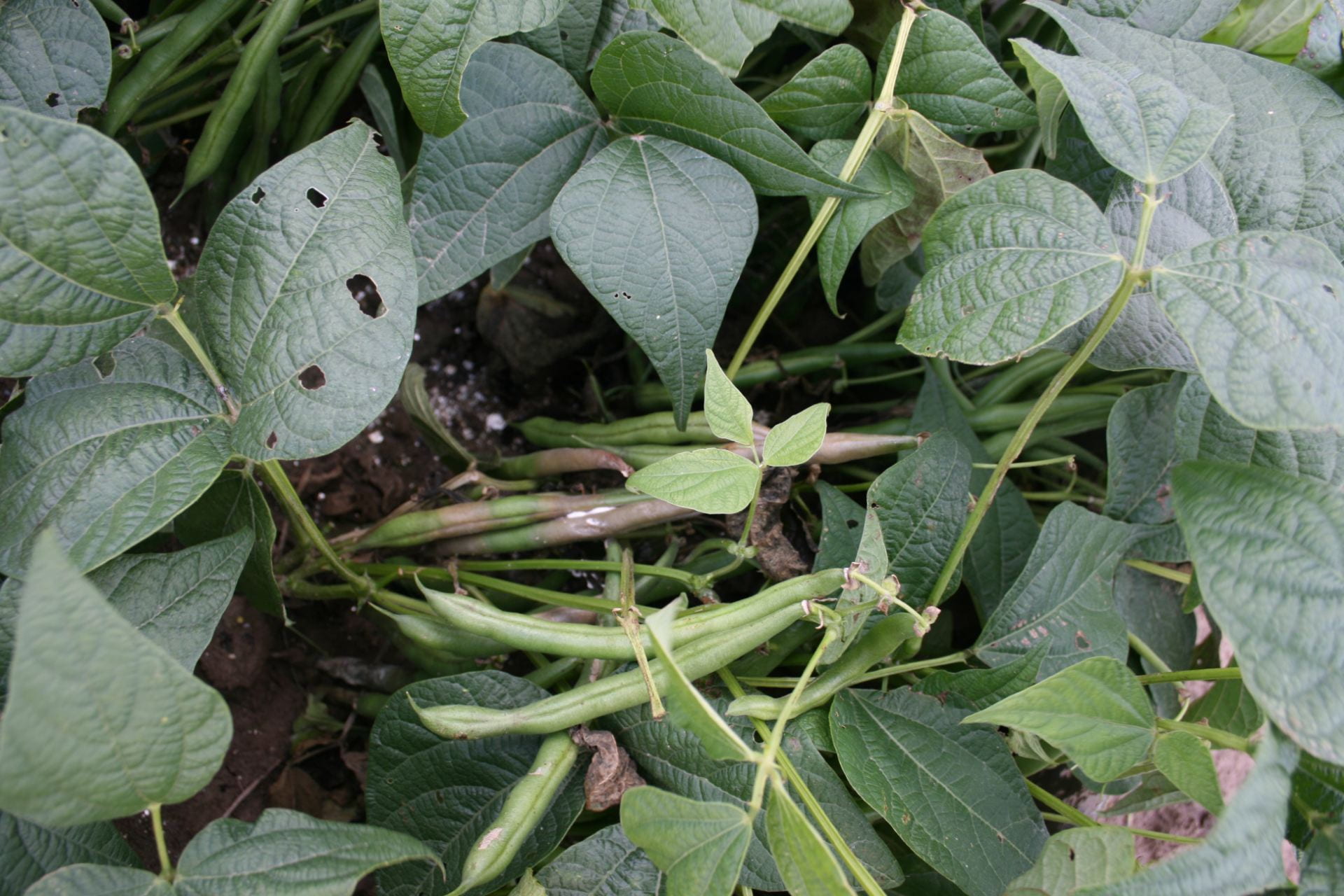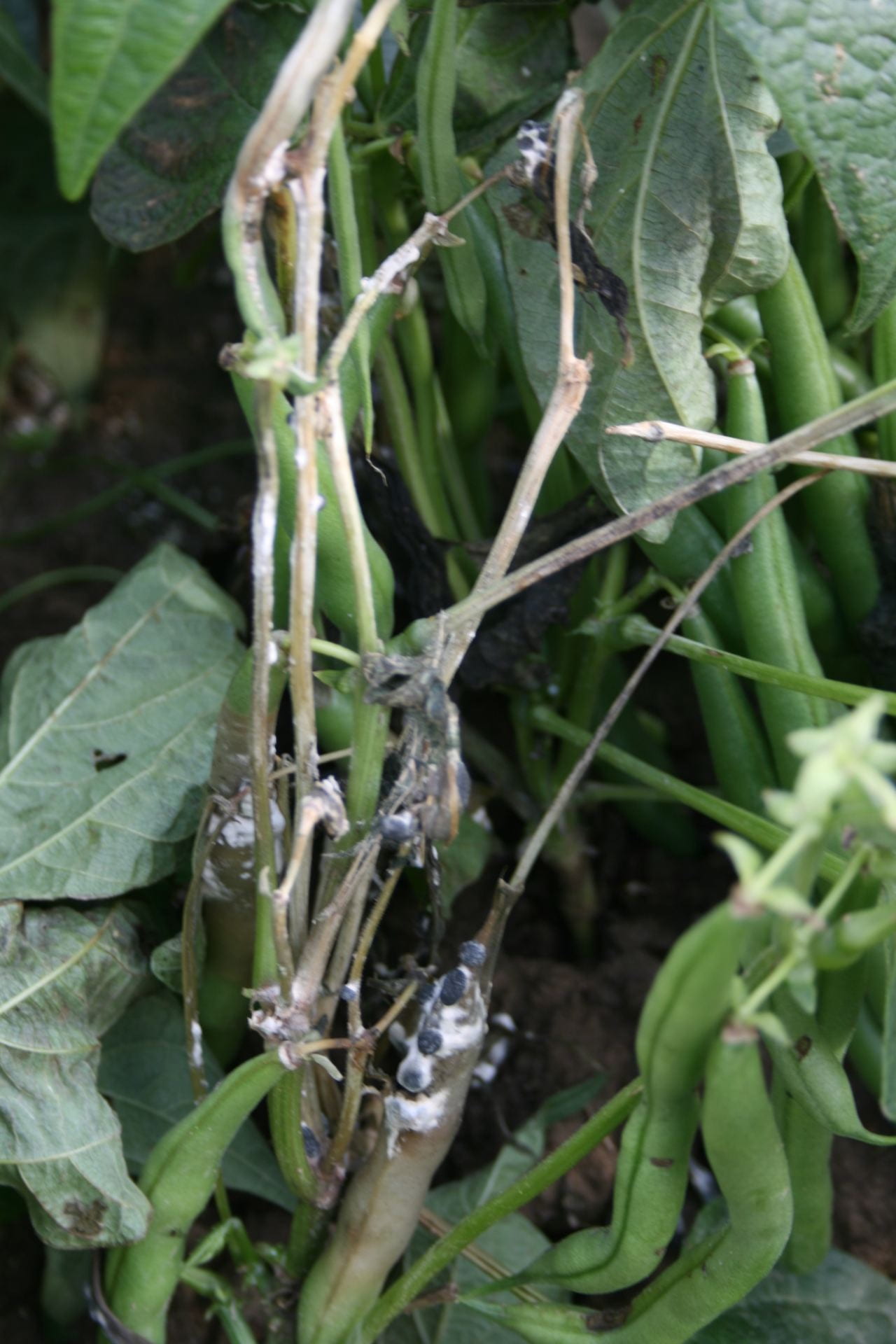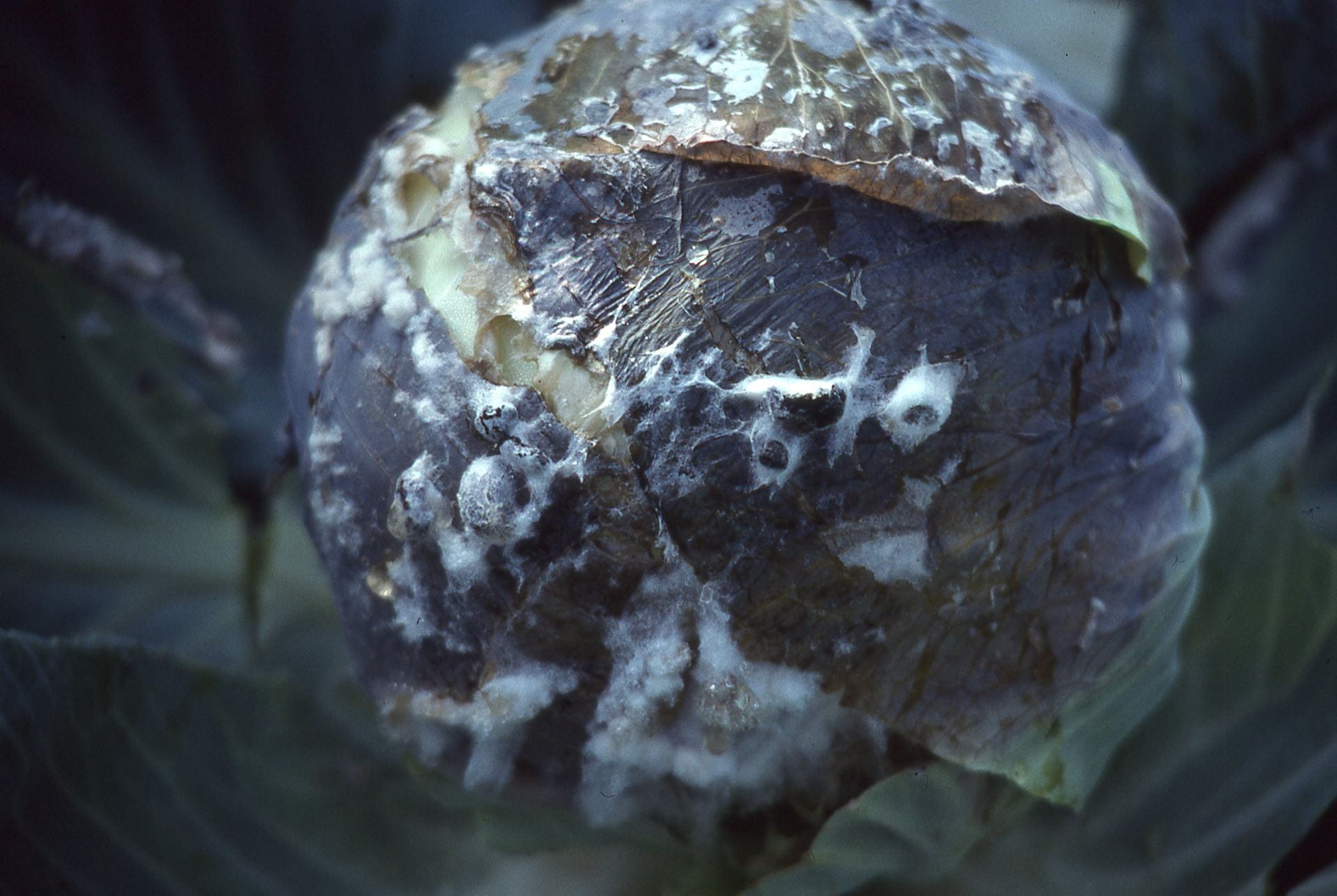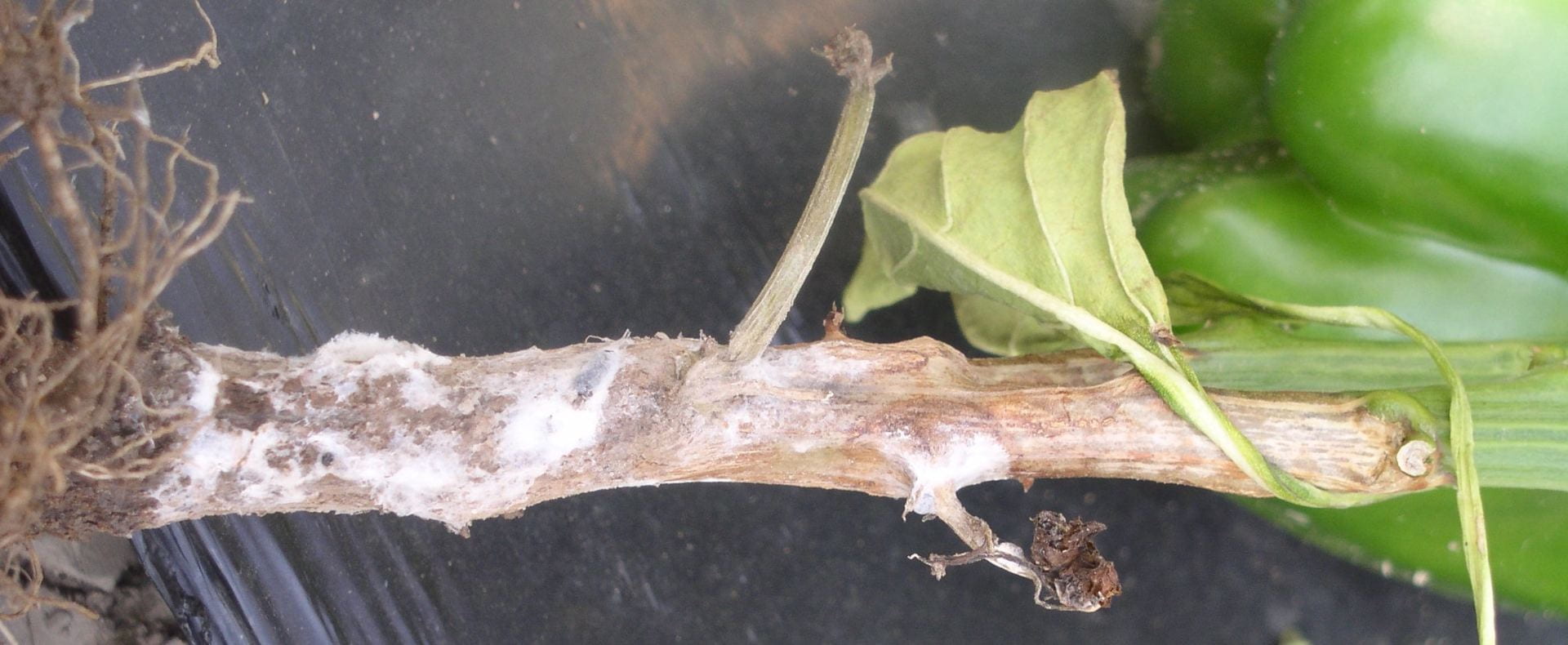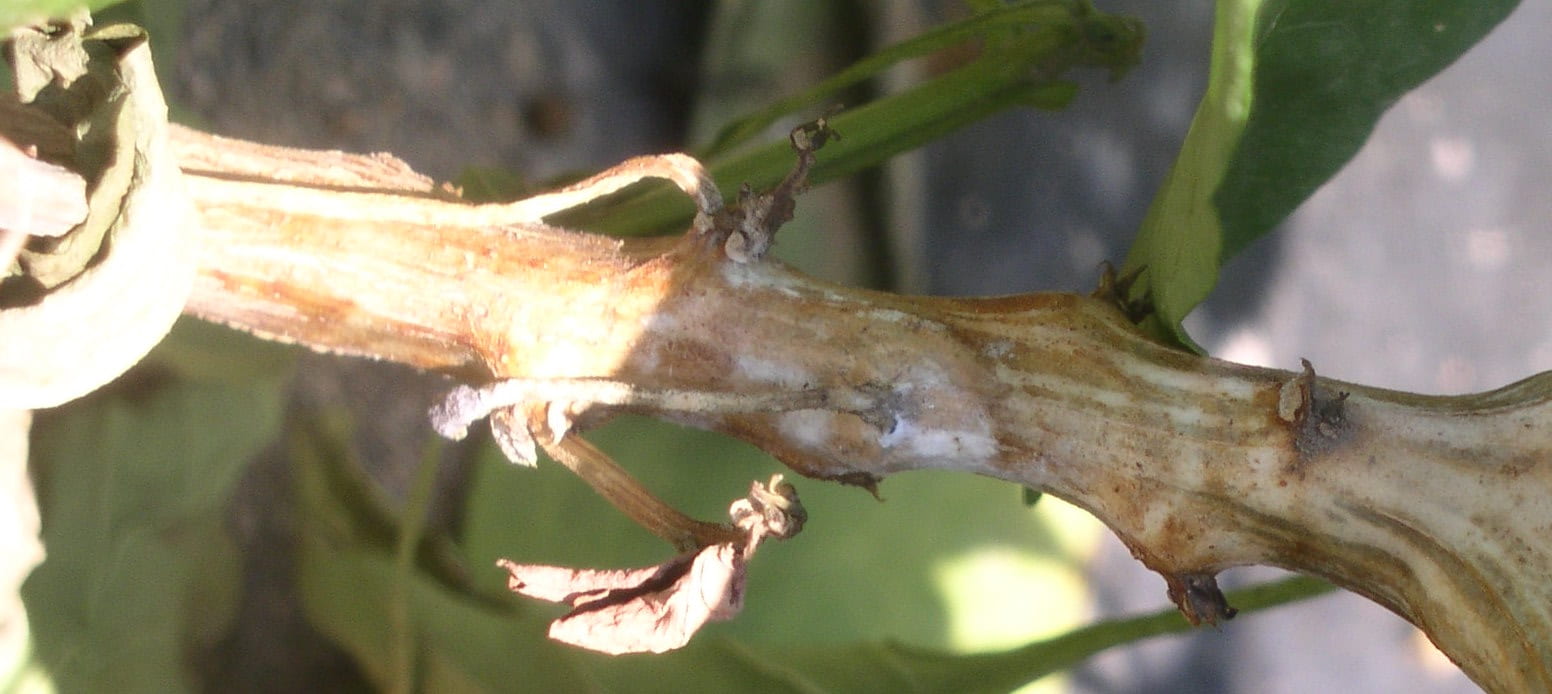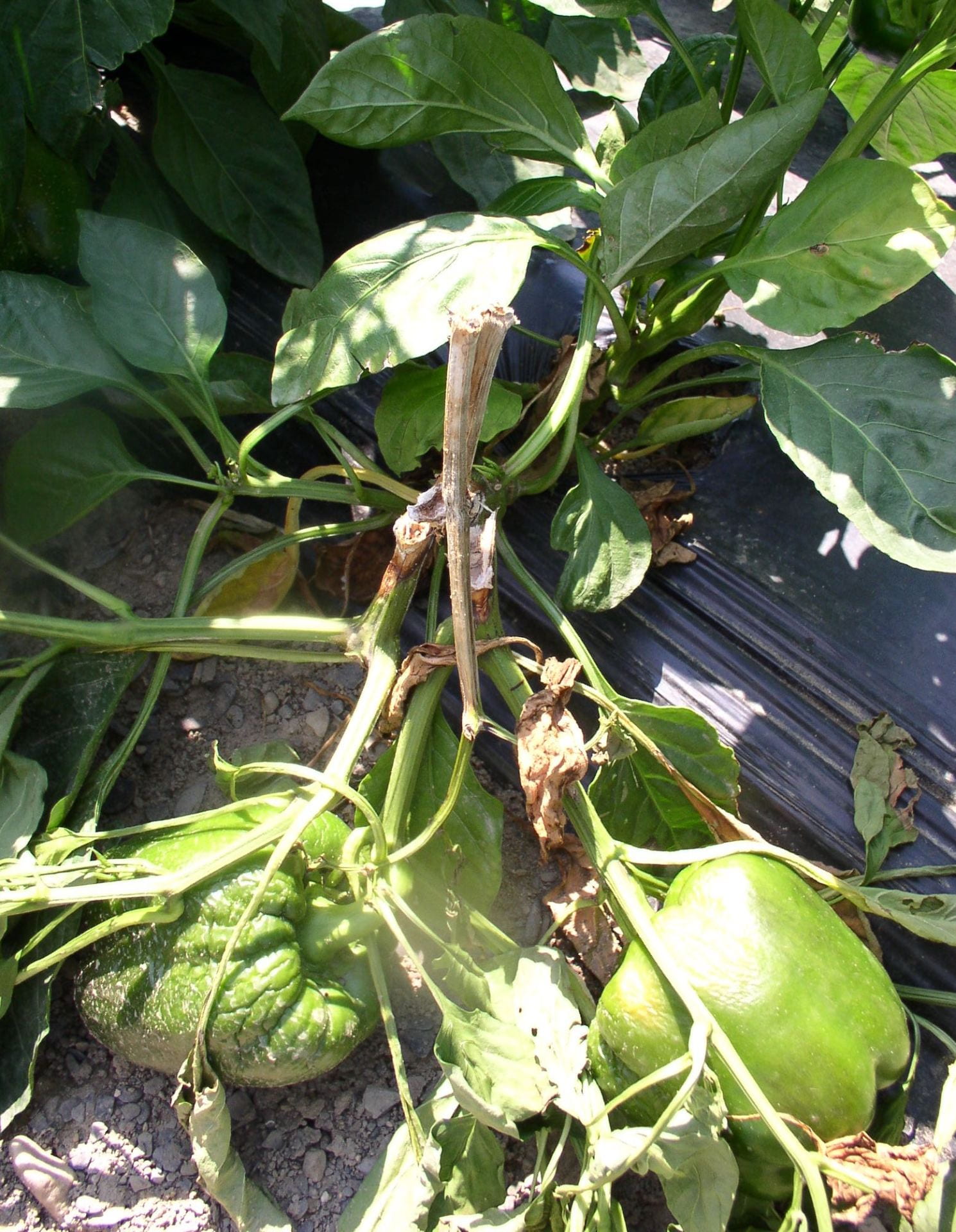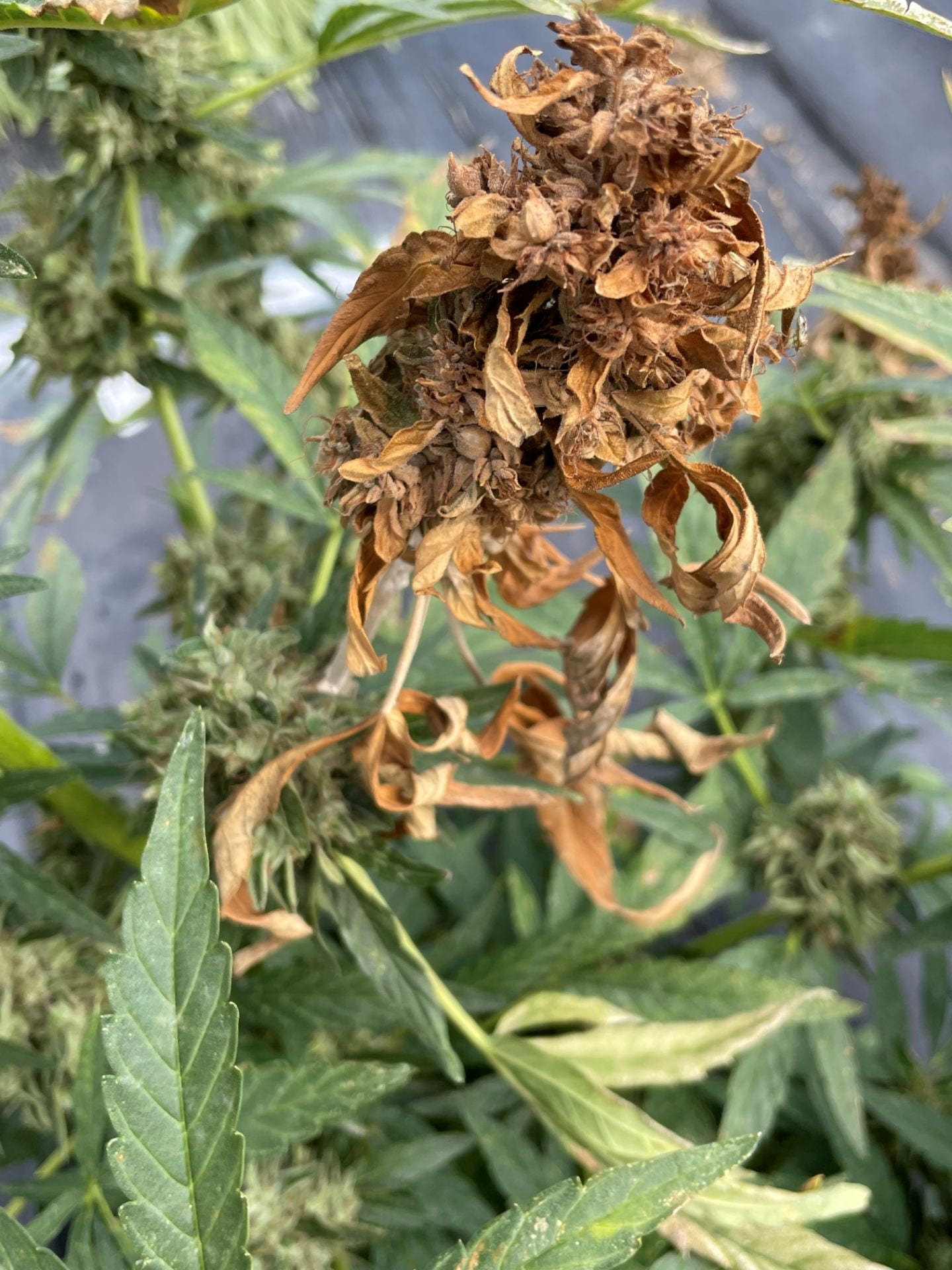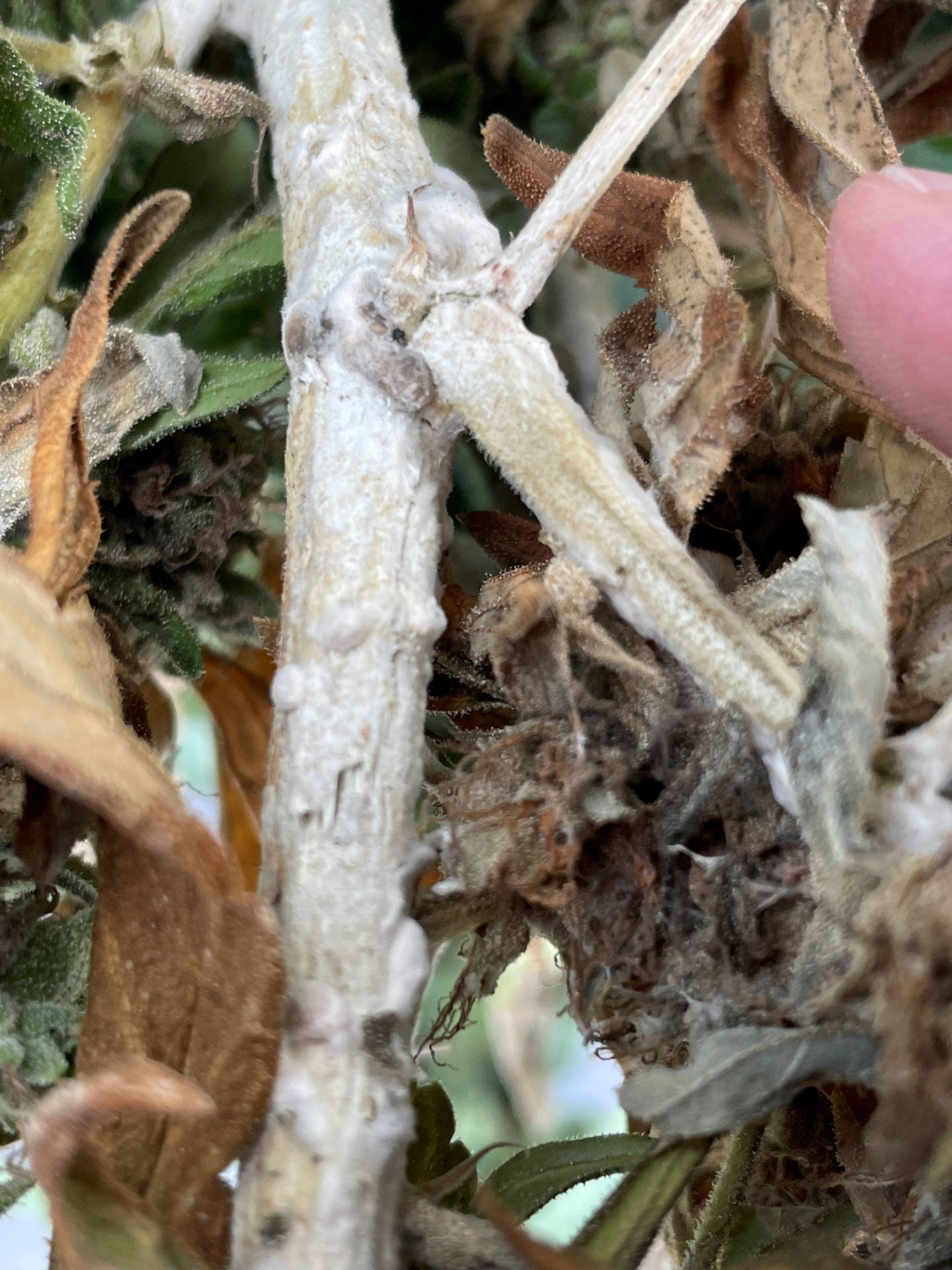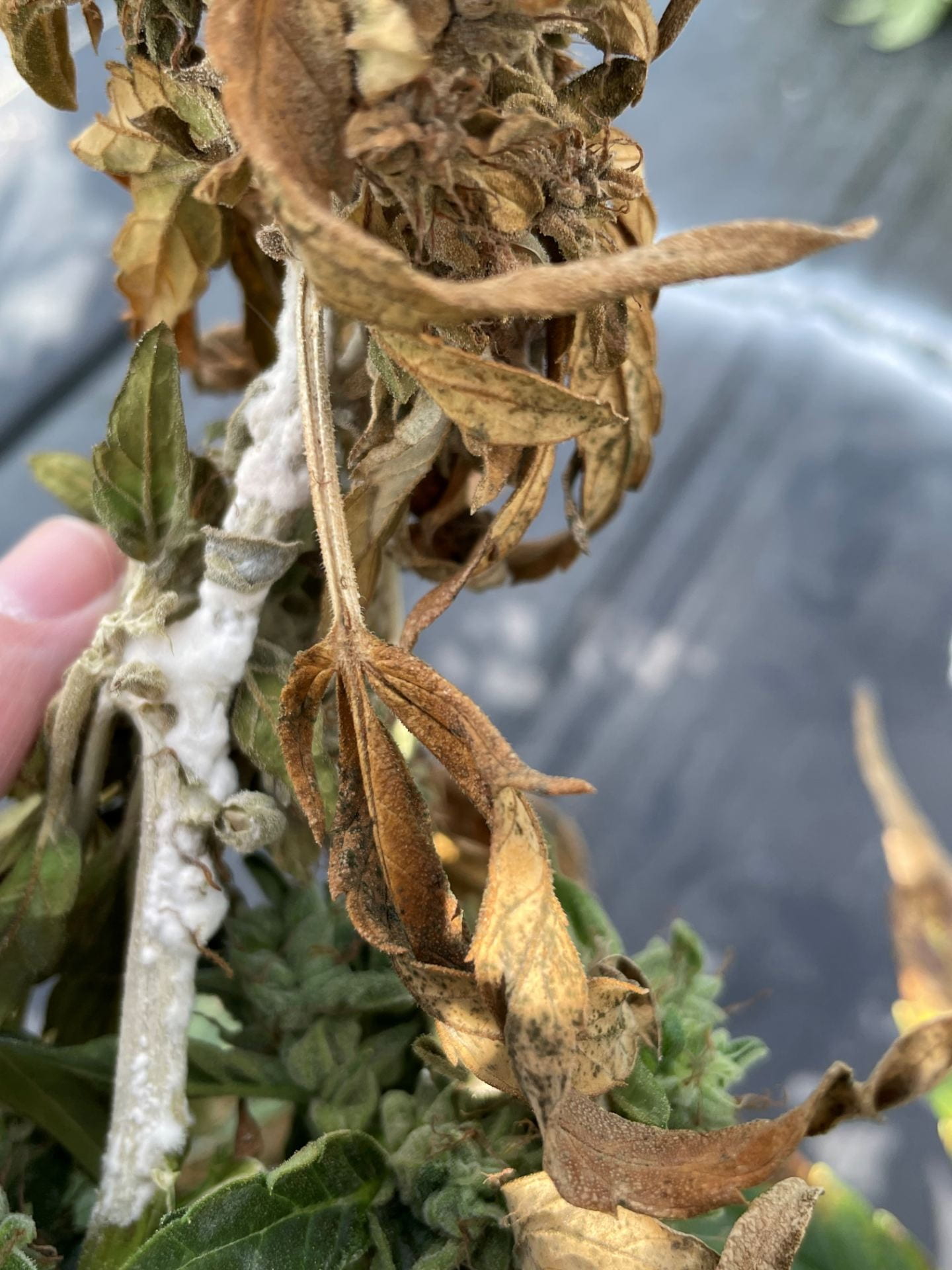aka Sclerotinia rot of cabbage, timber rot of tomato, and lettuce drop
Printer-friendly .pdf version of this page.
See also:
- White mold (Sclerotinia) in the APS Education Center
- Photographs of symptoms on beans, cabbage, lettuce, pepper, tomato, and winter squash.
Introduction
The pathogen has a broad host range and is known to attack over 360 species of plants. In the Cruciferae family alone, it has been recorded on 18 genera and 32 species. In New York, the fungus can infect many types of vegetables, as well as hemp, fruit and field crops (white mold is a major disease of soybean), and has been particularly serious on snap and dry beans in central and western regions where these crops are grown extensively primarily for processing. It also infects weeds such as velvetleaf, ragweed, dandelion, and wild clover, and has been found in hedgerows, woods, and in fruit orchards.
With cabbage, serious losses have occurred in the field, in storage, and under transit and market conditions.
For snap beans (aka green beans) and dry beans white mold is an important disease. Dry beans are at higher risk due to indeterminate flowering and longer time to crop maturity. White mold used to be more economically important in snap beans before sorting equipment on the processing line was improved with the addition of electronic eyes because, in addition to direct losses in the field, it was more costly and time consuming to remove affected pods without this equipment, thus detection of more than 2% diseased pods in a truckload at the processing plant could result in rejection of the whole load. Incidence of white mold has varied considerably in the major bean producing counties in central and western New York. Oswego, Wayne, Chautauqua, and Cattaraugus counties have had more frequent and more severe outbreaks than Ontario, Yates, Genesee, and Orleans counties. This difference may be due to variation in weather patterns, natural vegetation, and soil characteristics that result in extended periods of wet soil and moisture on the plants.
Causal Agent
The fungus that causes white mold, Sclerotinia sclerotiorum, is widely distributed in relatively cool and moist areas throughout the world.
Symptoms and Signs
Beans. Symptoms are usually first visible about one week after full bloom because blossoms generally are the first part of the plant to be colonized by the fungus. Leaves, stems, and pods in contact with the colonized blossoms can then become infected, provided moisture is present. Initial symptoms on these tissues are pale (often bleached) colored, water-soaked lesions. These lesions enlarge and within a few days, become covered with a white, cottony fungal growth and sclerotia (see below). Leaves of severely diseased plants become yellow and eventually turn brown and fall off. As the disease progresses, the infected plants wilt, and the canopy defoliates. The fungus may eventually invade and kill all above ground parts of the plants.
Below: White mold on snap beans. This disease is named for the characteristic white, cottony growth of the pathogen on infected plants. Diagnostic are the black, round to oblong sclerotia the pathogen produces in its white growth. (Photographs taken by C.D. Smart)
Cabbage can be infected during any growth stage, but most plants are infected in the field after midseason. Infections may occur on the stem at the soil line, on the leaves at their bases, or where the foliage meets the soil; but most infections originate at the top or on the sides of midseason to mature cabbage heads in New York. The infections begin as tan, water-soaked, circular areas, which soon become covered by white, cottony fungal growth. The host tissue becomes soft and watery as the disease progresses. The fungus eventually colonizes the entire cabbage head.
Below: White mold on cabbage head with sclerotia. (M.T. McGrath)
Other susceptible crops, most of which have been seen affected by white mold in New York, include other brassica crops, carrot, eggplant, lettuce, pepper (see below), potato, tomato, pea, pumpkin, and winter squash, plus hemp (see below) and soybean.
Sclerotia. The pathogen produces large, black, seedlike structures called sclerotia on diseased tissue and inside diseased stems and pods. It is important to look for them because they are diagnostic for white mold.
Below: White mold on pepper can be distinguished from Phytophthora blight, which also affects stems, by presence of white cottony fungal growth and sclerotia, additionally, with Phytophthora blight affected stems are darker brown and usually there are also symptoms on leaves and fruit plus the growing tip may be blighted. (Photos: C.D. Smart)
Disease Cycle
Sclerotia produced on diseased tissue are overwintering and survival structures, approximately 2 to 20 mm long. The sclerotia survive in a dormant state on or in the soil during the winter months. In the spring, summer, and fall months, under wet conditions, sclerotia develop small, tan, trumpet-shaped, mushroom-like structures called apothecia. Spores produced in the apothecia are called ascospores, which are forcibly discharged and carried by wind to susceptible plants. Apothecia are frequently found in moist, protected locations underneath the lower leaves of mature plants.
The ascospores require nutrients and a thin film of water on the plant surface to be able to germinate and infect a plant. Blossoms of many plants, including weeds, are an excellent source of nutrients for ascospore germination. The most frequently observed sources of nutrients in New York production fields are velvetleaf and common ragweed flowers, which have often been found infected by Sclerotinia sclerotiorum. Bean flowers are important in those crops. The pathogen grows from infected flower parts into healthy stem and pods when they are in contact with each other.
Cool (<85°F), moist conditions favor white mold development, but the fungus can grow over a broad temperature range. The fungus requires considerable moisture for the sclerotia to germinate and for the ascospores to infect plants. It has been observed that white mold is more prevalent in bean and cabbage crops where there is restricted air circulation caused by low areas and woods surrounding the field. This is because poor air drainage allows moisture to be retained in the soil and on the plants for a longer period of time. The resulting extended wet period favors development of white mold.
Management
Implementation of a single control measure will not be effective against white mold because it is caused by an aggressive pathogen with a broad host range. White mold can be managed most successfully by combining fungicide applications with cultural practices that suppress disease development. Additionally, it is valuable to scout crops and make written notes plus photographic records about the occurrence and severity of white mold.
Cultural practices:
- Resistant varieties. There are some resistant bean varieties including dry bean types, but no commercial varieties of snap bean have been bred to be resistant to white mold. Plant architecture influences development of white mold. Among susceptible varieties, select ones with open and upright canopies that hold pods off the ground.
- Field selection. Avoid planting the most susceptible crops in fields that are surrounded by dense woods that will restrict air circulation and subsequently delay drying. Rows should be planted in the direction of the prevailing winds to promote air drainage and drying of plant and soil surfaces. Use wide row spacing, 36 inches recommended, to promote drying of the soil and reduce moisture in the plant canopy. Fields with a history of white mold should be planted with non-susceptible crops such as grains (corn, rye, wheat, etc.). Cabbage and other susceptible crops (broccoli, cauliflower, beans, peas, etc.) should not be planted in fields where white mold has become a problem because continuous cropping of susceptible crops will result in a buildup of the fungus in the soil and further increased disease incidence.
- Avoid over fertilization. Excess nitrogen will promote canopy growth and resulting microclimatic conditions within the canopy will promote the retention of moisture for apothecia production, ascospore release, and infection.
- Crop rotation. A long rotation of at least three years out of susceptible crops is recommended because sclerotia can remain dormant in soil for long periods. Studies in New York have demonstrated that sclerotia degrade more rapidly when buried in the soil rather than being left on the surface.
- Good weed control. Research conducted at Cornell AgriTech (New York State Agricultural Experiment Station) has documented that removing all susceptible weeds, in particular ragweed, from the field can be very effective in preventing white mold on cabbage. It is also important to manage susceptible weeds in rotating with non-susceptible crop hosts.
- Avoid wounds. White mold tends to be worse in bean plantings where leaves have mechanical damage or pesticide injury. Bruises and other types of mechanical injuries to cabbage heads while developing and during harvesting operations leave wounds that can be colonized by the fungus that causes white mold. Research has shown that if ascospores are present on the leaf surfaces at harvest, bruises release sufficient nutrients to allow the fungus to infect the wounded area. In commercial storages, the fungus will completely colonize a bruised cabbage head and infect healthy cabbage heads that are in contact with the diseased tissues.
- Remove affected plants. In high tunnels and other production systems that are small in scale and used predominantly to grow susceptible crops like tomato and lettuce with limited rotation, it is worthwhile and economically feasible to physically remove affected plants so that sclerotia are not left to survive in the soil until the next planting of a susceptible crop.
- Incorporate debris promptly after harvest. Plowing affected fields immediately after harvest will reduce the production of sclerotia and also bury and hasten their decomposition, thereby reducing the amount of inoculum for future crops.
Fungicides:
- Soil application. The active ingredient in the biopesticide Contans WG is a parasitic fungus that attacks sclerotia. It can be applied to soil before planting, at planting, after transplant, or postharvest, and also to plant debris that remains in the field after harvest prior to replant of a susceptible crop. Contans is shipped frozen before use. It is labeled for use with most crops that are susceptible to white mold and approved for organic production.
- Foliar application. Successful control of white mold with foliar fungicides depends upon spraying at the proper time and obtaining thorough plant coverage. With beans, early bloom is the time to start applications because of the role that flowers play in initial disease development in a crop. Best spray coverage can be obtained by using high water volumes (50 gallons per acre minimum) and high pressure (100 to 200 psi). Use three nozzles per row mounted eight to ten inches above the plants and angled toward them. Fungicide sprays need to be directed to the blossoms to ensure they are covered because these are the parts that support spore germination and lead to invasion of other parts of the plant.
There are conventional fungicides in several FRAC groups (1, 2, 3, 7, 11, 12 and 29) labeled for white mold in addition to the contact fungicides copper and chlorothalonil. Several are labeled for use only on dry beans.
There are also OMRI-listed biopesticides. Copper is not recommended in beans during flowering due to phytotoxicity potential (flower abscission) in high temperatures.
For up-to-date information about labeled conventional fungicides see current Cornell Integrated Crop and Pest Management Guidelines for Commercial Vegetable Production. Biopesticide crop lists have labeled diseases.
Please Note: The specific directions on fungicide labels must be adhered to — they supersede these recommendations, if there is a conflict. If you are farming organically, before purchase make sure product is registered in your state and approved by your certifier. Any reference to commercial products, trade or brand names is for information only; no endorsement is intended.
Below: White mold on hemp. (C.D. Smart)
Prepared by:
Margaret Tuttle McGrath
Associate Professor
Long Island Horticultural Research and Extension Center (LIHREC)
Plant Pathology and Plant-Microbe Biology Section
School of Integrative Plant Science
College of Agriculture and Life Sciences
Cornell University
mtm3@cornell.edu
Originally prepared for VegetableMD Online website as a factsheet about white mold on beans by Helene R. Dillard and on cabbage by George S. Abawi and J. E. Hunter. Edited and updated August 2022 by Margaret Tuttle McGrath and Sarah Pethybridge.



